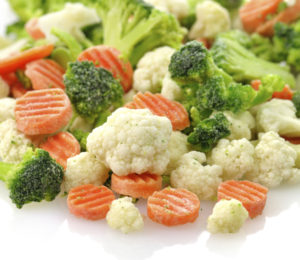 By: Carolyn Reynaud, MS, RD, LD —
By: Carolyn Reynaud, MS, RD, LD —
Following March’s National Nutrition Month now is a great opportunity for dietitians and health professionals to engage with consumers and clients in ways that help them balance their diet utilizing the most up-to-date guidelines. Health professionals and dietitians already know that a balanced diet is the keystone of optimal nutrition that supports a wide variety of benefits, such as a reduction in disease risk, weight management and improved quality of life. A proper diet even has the potential power to override genetics. However, for average Americans, this is not always common knowledge.
The Dietary Guidelines for Americans (DGAs) is the ultimate guide for what constitutes a balanced diet and the recent edition published in 2015 brought about many shifts to create recommendations that are better tailored to helping the individual succeed. This shift in guidance will help individuals achieve healthy eating patterns.
One recommendation of the DGAs (that is a mainstay and has not changed) is the guidance of eating a diet heavy in fruit and vegetables. Unfortunately, this is an area in which Americans continue to do poorly. Using 2013 data from the Behavioral Risk Factor Surveillance System (BRFSS), the Center for Disease Control (CDC) found that 76 percent of Americans surveyed did not meet fruit intake recommendations, and 87 percent did not meet vegetable intake recommendations. This means one out 10 Americans is not getting an adequate amount of fruits and veggies.
As health professionals, we have to do better job with our clients in discussing and strategizing how to integrate a variety of fruits and veggies in their diets. (Note: The Academy Of Nutrition and Dietetics (AND) shared a great hand out, linked here, that you can use with clients on ideas on how to meet the fruit and vegetable recommendations.)
“Variety” is a word you will see showcased frequently in recommendations for creating a well-rounded diet. While eating a diet that includes all the food groups such as fruit/veggies, grains, dairy and protein, it is important to stress that people should be varied in their intake within the individual groups to meet DGA recommendations.
The popularity of high protein diets is a good study on how variety can be used by the consumer to meet recommendations within a preferred diet. A client that feels higher protein is a good fit for them may be at risk for a diet with nutritional deficiencies if they are focused solely on animal protein. As dietitians we should try to educate clients on how they can also utilize plant and seafood protein as an alternative to help keep saturated fat under the recommended 10 percent of calories. Plant and seafood options are also provide beneficial nutrients like fiber and omega-3.
There is also a big focus in the DGA on substituting energy dense foods with nutrient dense foods. The recommendation is to limit saturated fat, salt and added sugars by replacing foods high in these ingredients with healthier options. One step taken to support this change is putting a quantifiable number on suggested added sugar intake. Added sugars have been a hot topic in nutrition for a while now and we are seeing a big push to reduce the amount in our diets.
Health professionals need to focus on empowering clients to be able navigate the world of added sugars in light of these changes. Tools like food calorie calculators, AND’s article on reading nutrition labels and this handout on reducing sugar intake are good examples of resources we can provide.
Finally, while reducing excess sugar is the goal, sustainability is also a key factor. This is where low- and reduced-calorie sweeteners/sugars can be helpful. The use of these products has been deemed safe and is supported by many reputable health agencies. There are a variety product options available of low/no-cal sweeteners that consumers can use as an alternative to sugar. We also see a variety of food manufacturers that are using low-calorie sweeteners in their products to meet consumer needs. Allulose is one such sweetener that is emerging on the market with a taste comparable to sugar. Keep your eyes open for more foods and beverages containing allulose in the near future.
Most importantly – we are lucky to have a growing body of information, resources and innovations that we can use to help people create their best and sustainable balanced diet.
 Carolyn Reynaud, MS, RD, LD is a licensed registered dietitian and a paid contributor to Allulose.org. She received her BS in nutrition from Michigan State University and her Masters and Certificate in Public Health from Georgia State University. She has experience working in several avenues of health care including corporate wellness, clinical disease management, research, and health promotion. She has been working as a health coach specialist for close to 6 years, where she counsels patients on preventative healthcare and helps them meet their health goals. Follow her on Twitter @ReynaudCari.
Carolyn Reynaud, MS, RD, LD is a licensed registered dietitian and a paid contributor to Allulose.org. She received her BS in nutrition from Michigan State University and her Masters and Certificate in Public Health from Georgia State University. She has experience working in several avenues of health care including corporate wellness, clinical disease management, research, and health promotion. She has been working as a health coach specialist for close to 6 years, where she counsels patients on preventative healthcare and helps them meet their health goals. Follow her on Twitter @ReynaudCari.

 e non-glycemic. Furthermore, when tested with other carbohydrate foods within a meal, it was actually found to suppress their glycemic response. This has the potential to have major implications for improving the palpability of diabetic foods and oral medications with a focus on blood sugar management.
e non-glycemic. Furthermore, when tested with other carbohydrate foods within a meal, it was actually found to suppress their glycemic response. This has the potential to have major implications for improving the palpability of diabetic foods and oral medications with a focus on blood sugar management.












